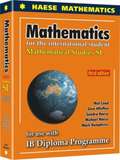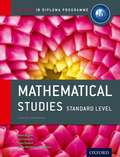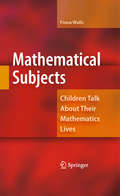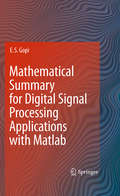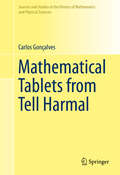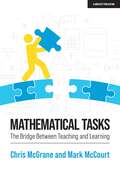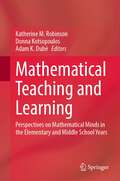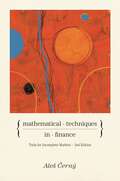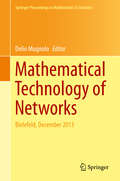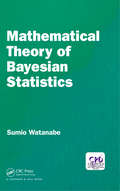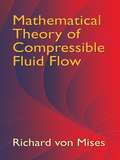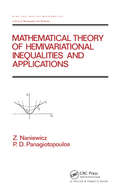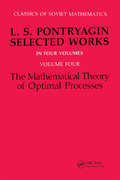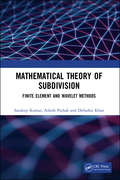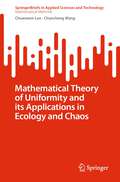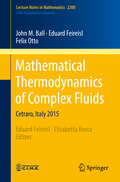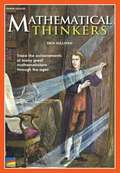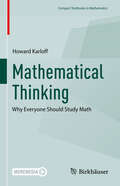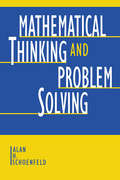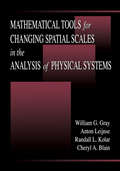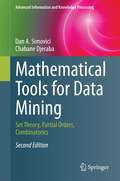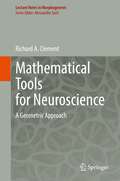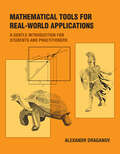- Table View
- List View
Mathematical Studies
by Mal Coad Glen Whiffen Sandra Haese Michael Haese Mark HumphriesMathematics for the International Student: Mathematical Studies SL has been written to embrace the syllabus for the two-year Mathematical Studies SL Course, to be first examined in 2014.
Mathematical studies Standard Level: Course Companion (Oxford IB Diploma Programme)
by Peter Blythe Jim Fensom Jane Forrest Paula Waldman de TokmanNumber and algebra 1, Descriptive statistics, Geometry and trigonometry 1, Mathematical models, Statistical applications, Introducing differential calculus, Number and algebra 2, Sets and probability, Logic, Geometry and trigonometry 2, Project, Getting the most out of your GDC, Prior learning.
Mathematical Subjects
by Fiona WallsWe know the process by which children become social, moral, and creative beings, but when--and how--do they become mathematical beings? This thought-provoking volume follows ten children (ages seven through eighteen) in schools in New Zealand, England, Australia, Sweden, and an international school in Switzerland as they come to recognize the mathematical as part of their lives, their academic identities, and their identities as human beings. Through these students' experiences important themes emerge, including mathematics as work, a domain of learning, and an avenue for competition; mathematical ability as a key to how they are perceived by others; and the relationships between mathematics achievement and the larger social and academic picture. This comparative study of educational systems and academic development will inform readers in these and other salient areas: Theoretical bases for understanding children as mathematical subjects. Help in creating the mathematical self: tutoring and related programs. The roles of compulsory study and standardized assessment. Class and ethnic content in children's math narratives. The gendering of mathematical ability and activity. What children's math experience can teach us about teaching the subject. Children Talk about Their Mathematics Lives opens bold windows onto how young people learn and how disparities arise, making it a cutting-edge resource for researchers and libraries, graduates and teachers in mathematics education and early childhood education.
Mathematical Summary for Digital Signal Processing Applications with Matlab
by E. S. GopiMathematical summary for Digital Signal Processing Applications with Matlab consists of Mathematics which is not usually dealt in the DSP core subject, but used in DSP applications. Matlab programs with illustrations are given for the selective topics such as generation of Multivariate Gaussian distributed sample outcomes, Bacterial foraging algorithm, Newton's iteration, Steepest descent algorithm, etc. are given exclusively in the separate chapter. Also Mathematical summary for Digital Signal Processing Applications with Matlab is written in such a way that it is suitable for Non-Mathematical readers and is very much suitable for the beginners who are doing research in Digital Signal Processing.
Mathematical Tablets from Tell Harmal
by Carlos GonçalvesThis work offers a re-edition of twelve mathematical tablets from the site of Tell Harmal, in the borders of present-day Baghdad. In ancient times, Tell Harmal was Saduppûm, a city representative of the region of the Diyala river and of the kingdom of Esnunna, to which it belonged for a time. These twelve tablets were originally published in separate articles in the beginning of the 1950s and mostly contain solved problem texts. Some of the problems deal with abstract matters such as triangles and rectangles with no reference to daily life, while others are stated in explicitly empirical contexts, such as the transportation of a load of bricks, the size of a vessel, the number of men needed to build a wall and the acquisition of oil and lard. This new edition of the texts is the first to group them, and takes into account all the recent developments of the research in the history of Mesopotamian mathematics. Its introductory chapters are directed to readers interested in an overview of the mathematical contents of these tablets and the language issues involved in their interpretation, while a chapter of synthesis discusses the ways history of mathematics has typically dealt with the mathematical evidence and inquires how and to what degree mathematical tablets can be made part of a picture of the larger social context. Furthermore, the volume contributes to a geography of the Old Babylonian mathematical practices, by evidencing that scribes at Saduppûm made use of cultural material that was locally available. The edited texts are accompanied by translations, philological, and mathematical commentaries.
A Mathematical Tapestry
by Peter Hilton Jean Pedersen Sylvie DonmoyerThis easy-to-read 2010 book demonstrates how a simple geometric idea reveals fascinating connections and results in number theory, the mathematics of polyhedra, combinatorial geometry, and group theory. Using a systematic paper-folding procedure it is possible to construct a regular polygon with any number of sides. This remarkable algorithm has led to interesting proofs of certain results in number theory, has been used to answer combinatorial questions involving partitions of space, and has enabled the authors to obtain the formula for the volume of a regular tetrahedron in around three steps, using nothing more complicated than basic arithmetic and the most elementary plane geometry. All of these ideas, and more, reveal the beauty of mathematics and the interconnectedness of its various branches. Detailed instructions, including clear illustrations, enable the reader to gain hands-on experience constructing these models and to discover for themselves the patterns and relationships they unearth.
Mathematical Tasks: The Bridge Between Teaching and Learning
by Chris McGrane Mark McCourtIf we want our pupils to develop fluency, understanding and the ability to solve complex problems, then it is vital that teachers develop the ability to select, adapt and design appropriate mathematical tasks. In 'Mathematical Tasks: The Bridge Between Teaching and Learning', Chris McGrane and Mark McCourt a range of practical approaches, strategies and principles behind the design and effective use of tasks in the mathematics classroom that lead to all pupils becoming successful learners. First-hand interviews with world class mathematics education experts and practicing teachers bring to life the ideas behind how tasks can act as a bridge between what the teacher wants the pupil to make sense of and what the pupil actually does makes sense of; tasks are how we enable pupils to enact mathematics - it is only by being mathematical that pupils can truly make connections across mathematical ideas and understand the bigger picture. This is a book for classroom teachers. Chris McGrane offers a range of practical examples for nurturing deep learning in mathematics that can be adapted and embedded in one's own classroom practice. This is also a book for those who are interested in the theory behind tasks. Chris and his interviewees examine the key role tasks play in shaping learning, teaching, curriculum and assessment. Suitable for teachers at all stages in their careers and teachers are encouraged to return to the book from time to time over the years to notice how their use of tasks in the classroom changes as they themselves develop.
Mathematical Tasks: The Bridge Between Teaching and Learning
by Chris McGrane Mark McCourtIf we want our pupils to develop fluency, understanding and the ability to solve complex problems, then it is vital that teachers develop the ability to select, adapt and design appropriate mathematical tasks. In 'Mathematical Tasks: The Bridge Between Teaching and Learning', Chris McGrane and Mark McCourt a range of practical approaches, strategies and principles behind the design and effective use of tasks in the mathematics classroom that lead to all pupils becoming successful learners. First-hand interviews with world class mathematics education experts and practicing teachers bring to life the ideas behind how tasks can act as a bridge between what the teacher wants the pupil to make sense of and what the pupil actually does makes sense of; tasks are how we enable pupils to enact mathematics - it is only by being mathematical that pupils can truly make connections across mathematical ideas and understand the bigger picture. This is a book for classroom teachers. Chris McGrane offers a range of practical examples for nurturing deep learning in mathematics that can be adapted and embedded in one's own classroom practice. This is also a book for those who are interested in the theory behind tasks. Chris and his interviewees examine the key role tasks play in shaping learning, teaching, curriculum and assessment. Suitable for teachers at all stages in their careers and teachers are encouraged to return to the book from time to time over the years to notice how their use of tasks in the classroom changes as they themselves develop.
Mathematical Teaching and Learning: Perspectives on Mathematical Minds in the Elementary and Middle School Years
by Katherine M. Robinson Donna Kotsopoulos Adam K. DubéThis book focusses on teaching and learning in elementary and middle school mathematics and suggests practices for teachers to help children be successful mathematical thinkers. Contributions from diverse theoretical and disciplinary perspectives are explored. Topics include the roles of technology, language, and classroom discussion in mathematics learning, the use of creativity, visuals, and teachers’ physical gestures to enhance problem solving, inclusive educational activities to promote children’s mathematics understanding, how learning in the home can enhance children’s mathematical skills, the application of mathematics learning theories in designing effective teaching tools, and a discussion of how students, teachers, teacher educators, and school boards differentially approach elementary and middle school mathematics. This book and its companion, Mathematical Cognition and Understanding, take an interdisciplinary perspective to mathematical learning and development in the elementary and middle school years. The authors and perspectives in this book draw from education, neuroscience, developmental psychology, and cognitive psychology. The book will be relevant to scholars/educators in the field of mathematics education and also those in childhood development and cognition. Each chapter also includes practical tips and implications for parents as well as for educators and researchers.
Mathematical Techniques in Finance: Tools for Incomplete Markets - Second Edition
by Ales CernýOriginally published in 2003, Mathematical Techniques in Finance has become a standard textbook for master's-level finance courses containing a significant quantitative element while also being suitable for finance PhD students. This fully revised second edition continues to offer a carefully crafted blend of numerical applications and theoretical grounding in economics, finance, and mathematics, and provides plenty of opportunities for students to practice applied mathematics and cutting-edge finance. Ales Cerný mixes tools from calculus, linear algebra, probability theory, numerical mathematics, and programming to analyze in an accessible way some of the most intriguing problems in financial economics. The textbook is the perfect hands-on introduction to asset pricing, optimal portfolio selection, risk measurement, and investment evaluation. The new edition includes the most recent research in the area of incomplete markets and unhedgeable risks, adds a chapter on finite difference methods, and thoroughly updates all bibliographic references. Eighty figures, over seventy examples, twenty-five simple ready-to-run computer programs, and several spreadsheets enhance the learning experience. All computer codes have been rewritten using MATLAB and online supplementary materials have been completely updated. A standard textbook for graduate finance courses Introduction to asset pricing, portfolio selection, risk measurement, and investment evaluation Detailed examples and MATLAB codes integrated throughout the text Exercises and summaries of main points conclude each chapter
Mathematical Technology of Networks
by Delio MugnoloDynamical models on graphs or random graphs are increasingly used in applied sciences as mathematical tools to study complex systems whose exact structure is too complicated to be known in detail. Besides its importance in applied sciences, the field is increasingly attracting the interest of mathematicians and theoretical physicists also because of the fundamental phenomena (synchronization, phase transitions etc. ) that can be studied in the relatively simple framework of dynamical models of random graphs. This volume was developed from the Mathematical Technology of Networks conference held in Bielefeld, Germany in December 2013. The conference was designed to bring together functional analysts, mathematical physicists, and experts in dynamical systems. The contributors to this volume explore the interplay between theoretical and applied aspects of discrete and continuous graphs. Their work helps to close the gap between different avenues of research on graphs, including metric graphs and ramified structures.
Mathematical Theory of Bayesian Statistics
by Sumio WatanabeMathematical Theory of Bayesian Statistics introduces the mathematical foundation of Bayesian inference which is well-known to be more accurate in many real-world problems than the maximum likelihood method. Recent research has uncovered several mathematical laws in Bayesian statistics, by which both the generalization loss and the marginal likelihood are estimated even if the posterior distribution cannot be approximated by any normal distribution. <P><P> Features <li>Explains Bayesian inference not subjectively but objectively. <li>Provides a mathematical framework for conventional Bayesian theorems. <li>Introduces and proves new theorems. <li>Cross validation and information criteria of Bayesian statistics are studied from the mathematical point of view. <li>Illustrates applications to several statistical problems, for example, model selection, hyperparameter optimization, and hypothesis tests. <li>This book provides basic introductions for students, researchers, and users of Bayesian statistics, as well as applied mathematicians. <P><P>Author <P><P>Sumio Watanabe is a professor of Department of Mathematical and Computing Science at Tokyo Institute of Technology. He studies the relationship between algebraic geometry and mathematical statistics.
Mathematical Theory of Compressible Fluid Flow
by Richard Von MisesA pioneer in the fields of statistics and probability theory, Richard von Mises (1883-1953) made notable advances in boundary-layer-flow theory and airfoil design. This text on compressible flow, unfinished upon his sudden death, was subsequently completed in accordance with his plans, and von Mises' first three chapters were augmented with a survey of the theory of steady plane flow. Suitable as a text for advanced undergraduate and graduate students -- as well as a reference for professionals -- Mathematical Theory of Compressible Fluid Flow examines the fundamentals of high-speed flows, with detailed considerations of general theorems, conservation equations, waves, shocks, and nonisentropic flows.In this, the final work of his distinguished career, von Mises summarizes his extensive knowledge of a central branch of fluid mechanics. Characteristically, he pays particular attention to the basics, both conceptual and mathematical. The novel concept of a specifying equation clarifies the role of thermodynamics in the mechanics of compressible fluids. The general theory of characteristics receives a remarkably complete and simple treatment, with detailed applications, and the theory of shocks as asymptotic phenomena appears within the context of rational mechanics.
Mathematical Theory of Hemivariational Inequalities and Applications (Chapman And Hall/crc Pure And Applied Mathematics Ser.)
by P. D. Panagiotopoulos Zdzistaw NaniewiczGives a complete and rigorous presentation of the mathematical study of the expressions - hemivariational inequalities - arising in problems that involve nonconvex, nonsmooth energy functions. A theory of the existence of solutions for inequality problems involving monconvexity and nonsmoothness is established.
Mathematical Theory of Optimal Processes: Selected Works (Classics Of Soviet Mathematics Ser.)
by L.S. PontryaginThe fourth and final volume in this comprehensive set presents the maximum principle as a wide ranging solution to nonclassical, variational problems. This one mathematical method can be applied in a variety of situations, including linear equations with variable coefficients, optimal processes with delay, and the jump condition. As with the three preceding volumes, all the material contained with the 42 sections of this volume is made easily accessible by way of numerous examples, both concrete and abstract in nature.
Mathematical Theory of Subdivision: Finite Element and Wavelet Methods
by Sandeep Kumar Ashish Pathak Debashis KhanThis book provides good coverage of the powerful numerical techniques namely, finite element and wavelets, for the solution of partial differential equation to the scientists and engineers with a modest mathematical background. The objective of the book is to provide the necessary mathematical foundation for the advanced level applications of these numerical techniques. The book begins with the description of the steps involved in finite element and wavelets-Galerkin methods. The knowledge of Hilbert and Sobolev spaces is needed to understand the theory of finite element and wavelet-based methods. Therefore, an overview of essential content such as vector spaces, norm, inner product, linear operators, spectral theory, dual space, and distribution theory, etc. with relevant theorems are presented in a coherent and accessible manner. For the graduate students and researchers with diverse educational background, the authors have focused on the applications of numerical techniques which are developed in the last few decades. This includes the wavelet-Galerkin method, lifting scheme, and error estimation technique, etc. Features: • Computer programs in Mathematica/Matlab are incorporated for easy understanding of wavelets. • Presents a range of workout examples for better comprehension of spaces and operators. • Algorithms are presented to facilitate computer programming. • Contains the error estimation techniques necessary for adaptive finite element method. This book is structured to transform in step by step manner the students without any knowledge of finite element, wavelet and functional analysis to the students of strong theoretical understanding who will be ready to take many challenging research problems in this area.
Mathematical Theory of Uniformity and its Applications in Ecology and Chaos (SpringerBriefs in Applied Sciences and Technology)
by Chuanwen Luo Chuncheng WangThis book puts forward a new mathematical theory to study chaotic phenomenon. The uniform theory is established on the basis of two elementary concept of circle and externally tangent square in mathematics. The author studies the uniformity of a finite set of points distributed in space by uniform theory. This book also illustrates that uniform theory performs better than other indices such as entropy and Lyapunov exponent in chaos measurement by numerous examples. This book develops a new mathematical tool for studying chaos so it will be appealing to students and researchers interested in theory of chaos. It also has potential applications in various fields such as Engineering, Forestry and Ecology.
Mathematical Thermodynamics of Complex Fluids: Cetraro, Italy 2015 (Lecture Notes in Mathematics #2200)
by Elisabetta Rocca Felix OttoEduard Feireisl Eduard Feireisl John M. BallThe main goal of this book is to provide an overview of the state of the art in the mathematical modeling of complex fluids, with particular emphasis on its thermodynamical aspects. The central topics of the text, the modeling, analysis and numerical simulation of complex fluids, are of great interest and importance both for the understanding of various aspects of fluid dynamics and for its applications to special real-world problems. New emerging trends in the subject are highlighted with the intent to inspire and motivate young researchers and PhD students.
Mathematical Thinkers: Set of 6 with Teacher Materials Non Common Core Edition (Navigators Ser.)
by Erin Sullivan Alison Adams Albert HannerNIMAC-sourced textbook
Mathematical Thinking: Why Everyone Should Study Math (Compact Textbooks in Mathematics)
by Howard KarloffThis textbook invites readers to explore mathematical thinking by finding the beauty in the subject. With an accessible tone and stimulating puzzles, the author will convince curious non-mathematicians to continue their studies in the area. It has an expansive scope, covering everything from probability and graph theory to infinities and Newton’s method. Many examples of proofs appear as well, offering readers the opportunity to explore these topics with the amount of rigor that suits them. Programming exercises in Python are also included to show how math behaves in action.Mathematical Thinking is an ideal textbook for transition courses aimed at undergraduates moving from lower level to more advanced topics, as well as for math recruitment and invitational courses at the freshman or sophomore level. It may also be of interest in computer science departments and can be used as a supplemental text for courses in discrete mathematics and graph theory.
Mathematical Thinking and Problem Solving (Studies in Mathematical Thinking and Learning Series)
by Alan H. SchoenfeldIn the early 1980s there was virtually no serious communication among the various groups that contribute to mathematics education -- mathematicians, mathematics educators, classroom teachers, and cognitive scientists. Members of these groups came from different traditions, had different perspectives, and rarely gathered in the same place to discuss issues of common interest. Part of the problem was that there was no common ground for the discussions -- given the disparate traditions and perspectives. As one way of addressing this problem, the Sloan Foundation funded two conferences in the mid-1980s, bringing together members of the different communities in a ground clearing effort, designed to establish a base for communication. In those conferences, interdisciplinary teams reviewed major topic areas and put together distillations of what was known about them.* A more recent conference -- upon which this volume is based -- offered a forum in which various people involved in education reform would present their work, and members of the broad communities gathered would comment on it. The focus was primarily on college mathematics, informed by developments in K-12 mathematics. The main issues of the conference were mathematical thinking and problem solving.
Mathematical Tools for Changing Scale in the Analysis of Physical Systems
by William G. Gray Anton Leijnse Randall L. Kolar Cheryl A. BlainMathematical Tools for Changing Scale in the Analysis of Physical Systems presents a new systematic approach to changing the spatial scale of the differential equations describing science and engineering problems. It defines vectors, tensors, and differential operators in arbitrary orthogonal coordinate systems without resorting to conceptually difficult Riemmann-Christoffel tensor and contravariant and covariant base vectors. It reveals the usefulness of generalized functions for indicating curvilineal, surficial, or spatial regions of integration and for transforming among these integration regions. These powerful mathematical tools are harnessed to provide 128 theorems in tabular format (most not previously available in the literature) that transform time-derivative and del operators of a function at one scale to the corresponding operators acting on the function at a larger scale. Mathematical Tools for Changing Scale in the Analysis of Physical Systems also provides sample applications of the theorems to obtain continuum balance relations for arbitrary surfaces, multiphase systems, and problems of reduced dimensionality. The mathematical techniques and tabulated theorems ensure the book will be an invaluable analysis tool for practitioners and researchers studying balance equations for systems encountered in the fields of hydraulics, hydrology, porous media physics, structural analysis, chemical transport, heat transfer, and continuum mechanics.
Mathematical Tools for Data Mining
by Dan A. Simovici Chabane DjerabaData mining essentially relies on several mathematical disciplines, many of which are presented in this second edition of this book. Topics include partially ordered sets, combinatorics, general topology, metric spaces, linear spaces, graph theory. To motivate the reader a significant number of applications of these mathematical tools are included ranging from association rules, clustering algorithms, classification, data constraints, logical data analysis, etc. The book is intended as a reference for researchers and graduate students. The current edition is a significant expansion of the first edition. We strived to make the book self-contained and only a general knowledge of mathematics is required. More than 700 exercises are included and they form an integral part of the material. Many exercises are in reality supplemental material and their solutions are included.
Mathematical Tools for Neuroscience: A Geometric Approach (Lecture Notes in Morphogenesis)
by Richard A. ClementThis book provides a brief but accessible introduction to a set of related, mathematical ideas that have proved useful in understanding the brain and behaviour. If you record the eye movements of a group of people watching a riverside scene then some will look at the river, some will look at the barge by the side of the river, some will look at the people on the bridge, and so on, but if a duck takes off then everybody will look at it. How come the brain is so adept at processing such biological objects? In this book it is shown that brains are especially suited to exploiting the geometric properties of such objects. Central to the geometric approach is the concept of a manifold, which extends the idea of a surface to many dimensions. The manifold can be specified by collections of n-dimensional data points or by the paths of a system through state space. Just as tangent planes can be used to analyse the local linear behaviour of points on a surface, so the extension to tangent spaces can be used to investigate the local linear behaviour of manifolds. The majority of the geometric techniques introduced are all about how to do things with tangent spaces.Examples of the geometric approach to neuroscience include the analysis of colour and spatial vision measurements and the control of eye and arm movements. Additional examples are used to extend the applications of the approach and to show that it leads to new techniques for investigating neural systems. An advantage of following a geometric approach is that it is often possible to illustrate the concepts visually and all the descriptions of the examples are complemented by comprehensively captioned diagrams.The book is intended for a reader with an interest in neuroscience who may have been introduced to calculus in the past but is not aware of the many insights obtained by a geometric approach to the brain. Appendices contain brief reviews of the required background knowledge in neuroscience and calculus.
Mathematical Tools for Real-World Applications: A Gentle Introduction for Students and Practitioners
by Alexandr DraganovTechniques for applying mathematical concepts in the real world: six rarely taught but crucial tools for analysis, research, and problem-solving.Many young graduates leave school with a solid knowledge of mathematical concepts but struggle to apply these concepts in practice. Real scientific and engineering problems are different from those found in textbooks: they are messier, take longer to solve, and standard solution recipes might not apply. This book fills the gap between what is taught in the typical college curriculum and what a practicing engineer or scientist needs to know. It presents six powerful tools for analysis, research, and problem-solving in the real world: dimensional analysis, limiting cases, symmetry, scaling, making order of magnitude estimates, and the method of successive approximations. The book does not focus on formulaic manipulations of equations, but emphasizes analysis and explores connections between the equations and the application. Each chapter introduces a set of ideas and techniques and then shows how these techniques apply to a series of problems. (Knowledge of algebra and trigonometry, but not calculus, is required.) The final two chapters tie all six techniques together and apply them to two real-world problems: computing the probability of a rare, catastrophic event, and tracking a satellite with a GPS receiver. Readers will learn how to analyze, dissect, and gain insight into the results by using all the techniques presented in earlier chapters—and discover how analysis tools work on problems not concocted for a textbook. The appendix provides solutions to many of the problems found throughout the book. Alexandr Draganov was born and raised in Kyiv, Ukraine; in light of the current war in Ukraine he will donate 100% of his royalties for the first year to support medical and humanitarian efforts there.
